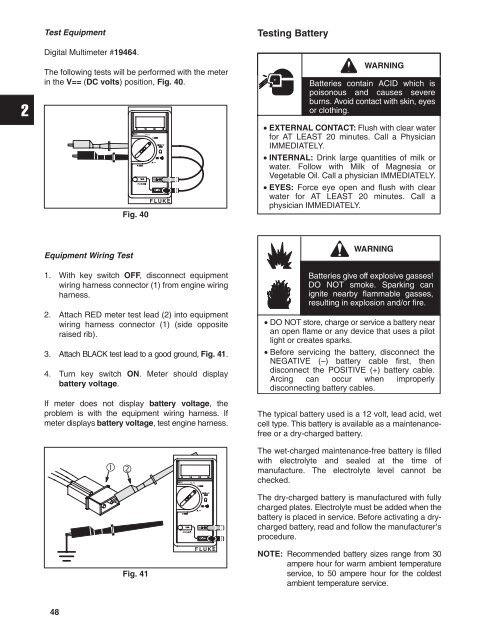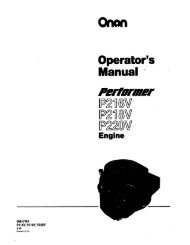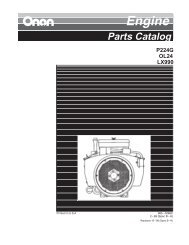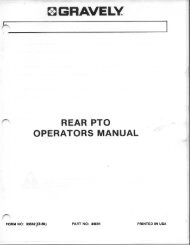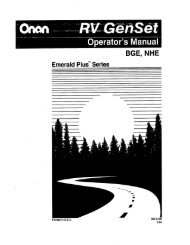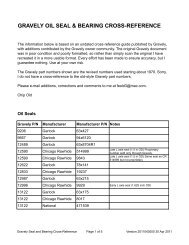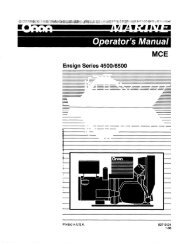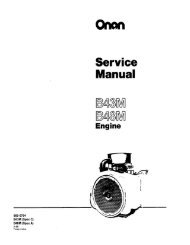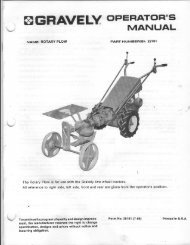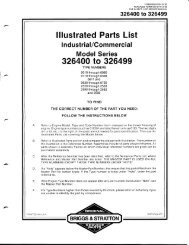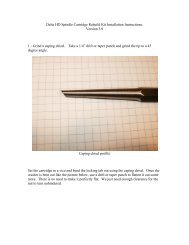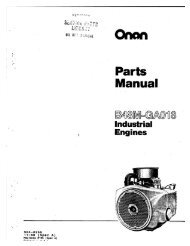272144 Vanguard Twin Cylinder OHV BRIGGS & STRATTON.pdf
272144 Vanguard Twin Cylinder OHV BRIGGS & STRATTON.pdf
272144 Vanguard Twin Cylinder OHV BRIGGS & STRATTON.pdf
Create successful ePaper yourself
Turn your PDF publications into a flip-book with our unique Google optimized e-Paper software.
Test Equipment<br />
Testing Battery<br />
Digital Multimeter #19464.<br />
The following tests will be performed with the meter<br />
in the V== (DC volts) position, Fig. 40.<br />
Fig. 40<br />
WARNING<br />
Batteries contain ACID which is<br />
poisonous and causes severe<br />
burns. Avoid contact with skin, eyes<br />
or clothing.<br />
• EXTERNAL CONTACT: Flush with clear water<br />
for AT LEAST 20 minutes. Call a Physician<br />
IMMEDIATELY.<br />
• INTERNAL: Drink large quantities of milk or<br />
water. Follow with Milk of Magnesia or<br />
Vegetable Oil. Call a physician IMMEDIATELY.<br />
• EYES: Force eye open and flush with clear<br />
water for AT LEAST 20 minutes. Call a<br />
physician IMMEDIATELY.<br />
Equipment Wiring Test<br />
1. With key switch OFF, disconnect equipment<br />
wiring harness connector (1) from engine wiring<br />
harness.<br />
2. Attach RED meter test lead (2) into equipment<br />
wiring harness connector (1) (side opposite<br />
raised rib).<br />
3. Attach BLACK test lead to a good ground, Fig. 41.<br />
4. Turn key switch ON. Meter should display<br />
battery voltage.<br />
If meter does not display battery voltage, the<br />
problem is with the equipment wiring harness. If<br />
meter displays battery voltage, test engine harness.<br />
<br />
WARNING<br />
Batteries give off explosive gasses!<br />
DO NOT smoke. Sparking can<br />
ignite nearby flammable gasses,<br />
resulting in explosion and/or fire.<br />
• DO NOT store, charge or service a battery near<br />
an open flame or any device that uses a pilot<br />
light or creates sparks.<br />
• Before servicing the battery, disconnect the<br />
NEGATIVE (–) battery cable first, then<br />
disconnect the POSITIVE (+) battery cable.<br />
Arcing can occur when improperly<br />
disconnecting battery cables.<br />
The typical battery used is a 12 volt, lead acid, wet<br />
cell type. This battery is available as a maintenancefree<br />
or a dry-charged battery.<br />
The wet-charged maintenance-free battery is filled<br />
with electrolyte and sealed at the time of<br />
manufacture. The electrolyte level cannot be<br />
checked.<br />
The dry-charged battery is manufactured with fully<br />
charged plates. Electrolyte must be added when the<br />
battery is placed in service. Before activating a drycharged<br />
battery, read and follow the manufacturer’s<br />
procedure.<br />
Fig. 41<br />
NOTE: Recommended battery sizes range from 30<br />
ampere hour for warm ambient temperature<br />
service, to 50 ampere hour for the coldest<br />
ambient temperature service.<br />
48


